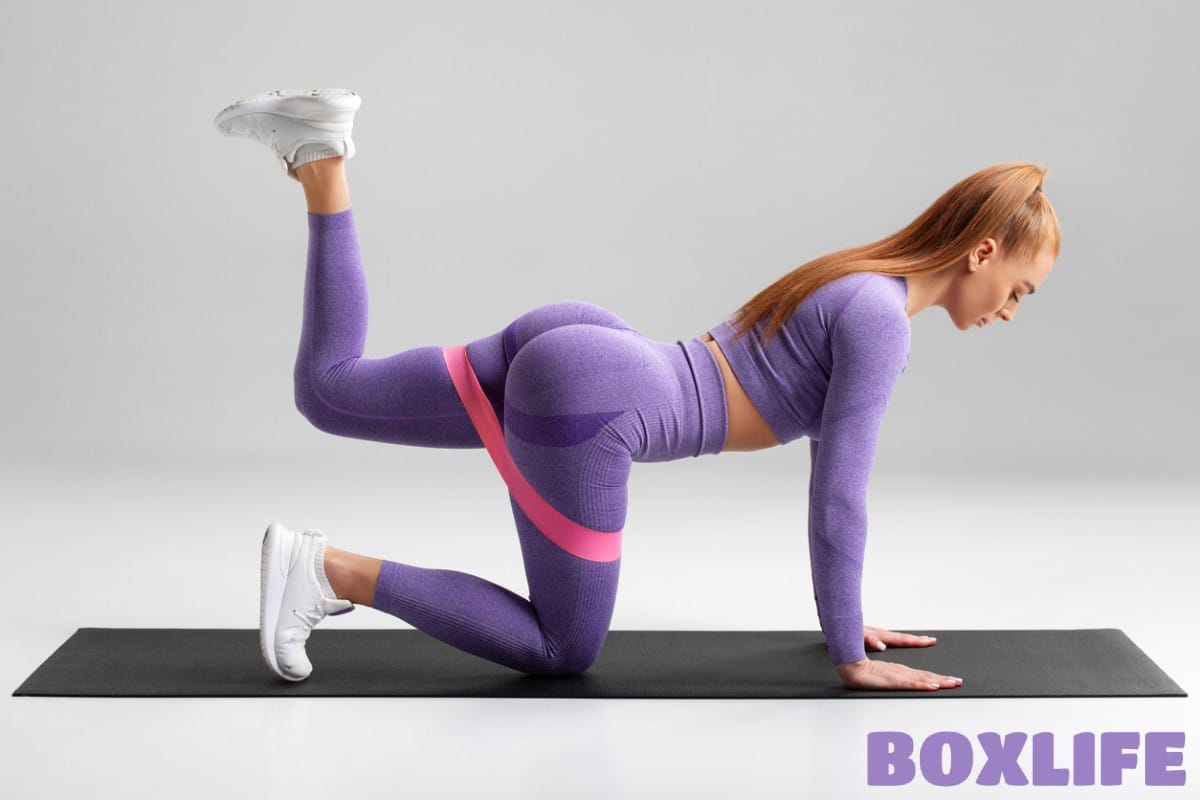If you’re aiming to build a strong and visually appealing lower body, the gluteal muscles, or glutes, should be your primary focus.
Today, we’ll guide you through the most effective exercises for targeting your lower glutes. Our recommendations are not based on mere opinions; they are backed by scientific studies and expert advice to ensure you achieve optimal results.
We’ll delve into the anatomy of the glutes, breaking down each muscle’s role and importance in lower body movements. This understanding will provide you with a solid foundation to approach your underbutt training and workouts with confidence and precision.
So, let’s get started on your journey to a stronger, more sculpted lower body.
Jump to:
- Anatomy of the Glutes
- Benefits of These Exercises for Under Buttocks
- Common Challenges and Solutions
- Comprehensive List of Lower Glute Exercises
- Hip Thrusts
- Single-Leg Hip Thrusts
- Glute Bridges
- Single-Leg Glute Bridges
- Cable Kickbacks
- Cable Pull Throughs
- Deadlifts
- Romanian Deadlifts
- Single Leg Romanian Deadlift
- Stiff-Leg Deadlifts
- Good Mornings
- Lunges
- Bulgarian Split Squats
- Step-Ups
- Donkey Kicks
- Fire Hydrants
- Clamshells
- Side-Lying Leg Lifts
- Quadruped Hip Extensions
- Stability Ball Glute Bridge with Hamstring Curl
- Prone Bench Lying Dumbbell Hamstring Curl
- Workout Routines for the Underbutt
- Nutrition and Recovery
- FAQs
- Sources
Anatomy of the Glutes
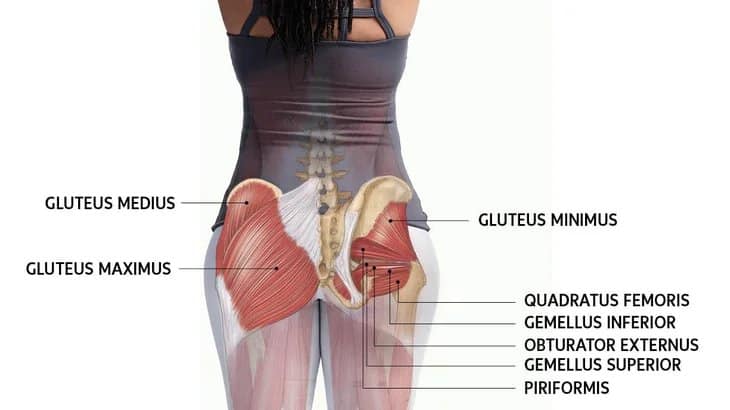
When we talk about sculpting a strong, well-defined lower body, the glutes are often the star of the show. But do we really know what makes up this powerhouse muscle group? Let’s dive deep into the anatomy of the glutes to understand how we can effectively target and strengthen them.
The gluteal muscles, commonly referred to as the glutes, are composed of three main muscles: the gluteus maximus, gluteus medius, and gluteus minimus. Each of these muscles plays a crucial role in the movement and stability of the lower body.
The Gluteus Maximus
The gluteus maximus is the largest and most superficial of the three gluteal muscles. It’s responsible for the shape and roundness of your buttocks. When we talk about lower glute exercises, we’re primarily targeting the lower fibers of this muscle. The gluteus maximus extends and externally rotates the hip, playing a vital role in activities like running, jumping, and climbing.
The Gluteus Medius and Minimus
The gluteus medius and minimus are smaller muscles located beneath the gluteus maximus. They work together to abduct the hip (move the leg away from the body) and stabilize the pelvis during movement. A strong gluteus medius and minimus can help prevent injuries and improve overall lower body strength and stability.
How the Glutes Interact with Other Muscles
The glutes don’t work in isolation. They’re part of a complex network of muscles that includes the hamstrings, quadriceps, and lower back muscles. Together, these muscles work in harmony to support the pelvis and spine, allowing us to move efficiently and maintain proper posture.
When we perform underbutt exercises, we’re not just targeting the gluteus maximus. We’re also engaging the surrounding muscles, creating a synergistic effect that enhances the overall strength and functionality of the lower body.
Benefits of These Exercises for Under Buttocks
Improved Posture
Engaging in underbutt exercises can significantly improve your posture. The glutes play a crucial role in stabilizing the pelvis and supporting the spine. When the glutes are strong and activated, they help maintain proper alignment, reducing the risk of posture-related issues. This is particularly important for individuals who spend long hours sitting, as it can counteract the negative effects of a sedentary lifestyle.
Alleviation of Back Pain
These exercises can be a game-changer for those suffering from back pain. Weak glutes often contribute to lower back pain because other muscles have to compensate for their lack of strength, leading to muscle imbalances and discomfort. Strengthening the glutes can alleviate back pain by providing better support to the spine and reducing the strain on the lower back.
Enhanced Sports Performance
For athletes and fitness enthusiasts, underbutt exercises can significantly enhance sports performance. The glutes are involved in various movements such as running, jumping, and changing direction. Strengthening the lower glutes can improve power, agility, and overall athletic performance. It can also reduce the risk of injuries by ensuring that the glutes are adequately supporting the lower body during physical activity.
Aesthetic Benefits
Let’s not forget the aesthetic benefits of glute training. A strong, well-defined lower glute area contributes to a perky butt and a defined underbutt crease, which many people desire. Incorporating lower glute exercises into your fitness routine can help you achieve a more sculpted and lifted appearance, boosting your confidence and self-esteem.
Common Challenges and Solutions
Difficulty Isolating the Lower Glutes
One of the most common challenges people face when working on their lower glutes is difficulty isolating the muscles. It’s not uncommon to feel the burn in your hamstrings or lower back instead of your glutes. The key to overcoming this challenge is to focus on proper form and technique. Make sure you’re engaging your glutes and not relying on other muscle groups to do the work.
Importance of Mind-Muscle Connection
The mind-muscle connection plays a crucial role in effectively targeting the lower glutes. This involves actively thinking about the muscle you’re working on and consciously engaging it during exercises. It might sound simple, but it can make a significant difference in the effectiveness of your workout. Practice makes perfect, so don’t get discouraged if it takes some time to develop this connection.
Tips for Activating the Underbutt During Exercises
Here are some tips to help you activate your lower glutes during exercises:
- Warm-Up Properly: Start with a good warm-up to activate your glutes and prepare them for the workout. This can include exercises like glute bridges, clamshells, and leg lifts.
- Use Resistance Bands: Incorporating resistance bands into your workout can help target the lower glutes more effectively. Place the band around your thighs or ankles and focus on pushing against the resistance.
- Focus on Form: Pay attention to your form and make sure you’re engaging your glutes throughout the exercise. Avoid arching your back or using momentum to complete the movement.
- Slow Down the Movement: Slow down the movement and focus on the eccentric (lowering) phase of the exercise. This can help increase muscle activation and improve your mind-muscle connection.
- Incorporate Unilateral Exercises: Unilateral exercises, like single-leg deadlifts and lunges, can help address muscle imbalances and ensure both sides of your lower glutes are being worked equally.
Comprehensive List of Lower Glute Exercises
Here’s how I ranked each exercise for your convenience:
- Hip Thrusts and Single-Leg Hip Thrusts: These exercises are amongst the best for targeting the glutes, including the underbutt. They isolate the glute muscles and allow for a full range of motion.
- Glute Bridges and Single-Leg Glute Bridges: These exercises are similar to hip thrusts and are effective for isolating the glutes.
- Cable Kickbacks and Cable Pull Throughs: These exercises use cable machines to add resistance and target the lower butt.
- Deadlifts, Romanian Deadlifts, and Single-Leg Deadlifts: These exercises are compound movements that work multiple muscle groups, including the lower glutes. They are effective for building strength and muscle mass.
- Lunges, Bulgarian Split Squats, and Step-Ups: These exercises are great for targeting the lower glutes and also work the quads and hamstrings.
- Donkey Kicks, Fire Hydrants, Clamshells, Side-Lying Leg Lifts, and Quadruped Hip Extensions: These exercises are often used for glute activation and are great for targeting the lower glutes.
- Stability Ball Glute Bridge with Hamstring Curl and Prone Bench Lying Dumbbell Hamstring Curl: These exercises target the glutes and hamstrings and can be effective for building lower glute strength.
Hip Thrusts
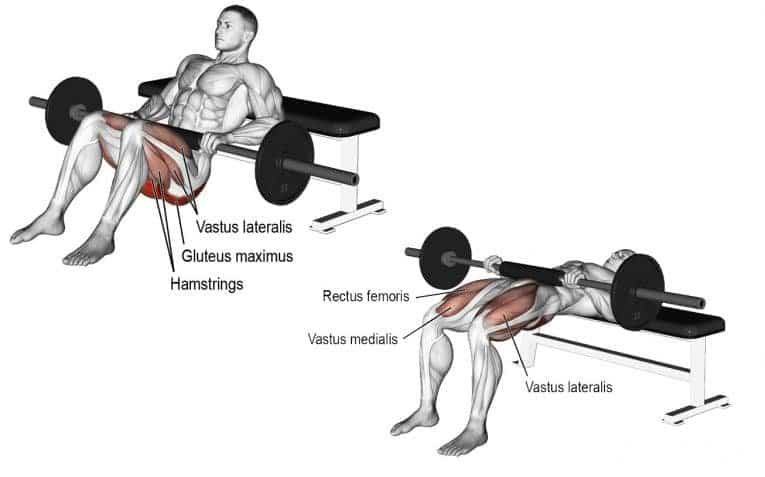
Hip thrusts are a staple exercise for building strong and well-shaped glutes. This exercise can be done with or without weights.
How to do Hip Thrusts:
- Sit on the ground with your back against a bench and a weight on your hips.
- Plant your feet on the ground, shoulder-width apart.
- Drive through your heels, lifting your hips towards the ceiling.
- Squeeze your glutes at the top and slowly lower back down.
Single-Leg Hip Thrusts
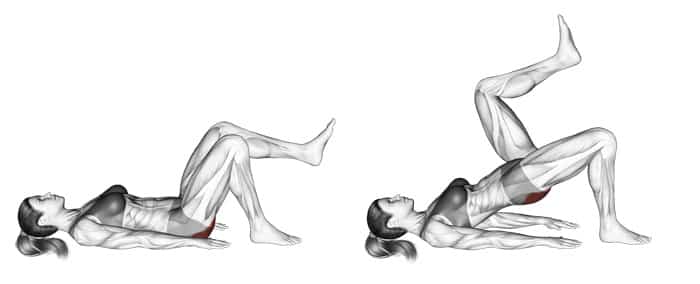
Single-leg hip thrusts are a variation of the classic hip thrust that targets the lower glutes and hamstrings.
How to do Single-Leg Hip Thrusts:
- Sit on the ground with your back against a bench and a barbell across your hips.
- Lift one leg towards the ceiling.
- Push through your heel to lift your hips towards the ceiling, squeezing your glutes at the top.
- Lower back down and repeat on the other side.
Glute Bridges

Glute bridges are a classic exercise that targets the lower glutes, hamstrings, and lower back.
How to do Glute Bridges:
- Lie on your back with your knees bent and feet hip-width apart.
- Push through your heels to lift your hips towards the ceiling, squeezing your glutes at the top.
- Lower back down and repeat.
Single-Leg Glute Bridges
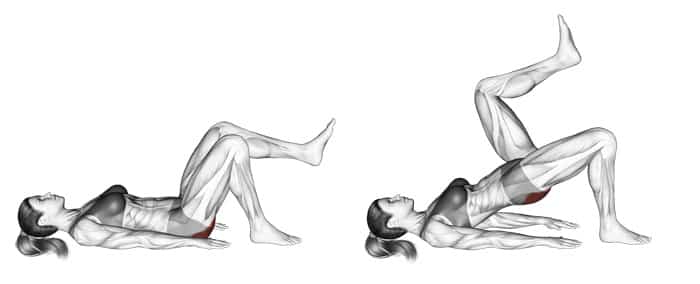
Single-leg glute bridges are a variation of the classic glute bridge that targets the lower glutes and hamstrings.
How to do Single-Leg Glute Bridges:
- Lie on your back with your knees bent and feet hip-width apart.
- Lift one leg towards the ceiling.
- Push through your heel to lift your hips towards the ceiling, squeezing your glutes at the top.
- Lower back down and repeat on the other side.
Cable Kickbacks

Cable kickbacks are an excellent exercise to target the lower glutes and hamstrings. This exercise requires a cable machine.
How to do Cable Kickbacks:
- Attach an ankle strap to a low cable machine and secure it around your ankle.
- Facing the machine, bend at the hips and place your hands on the machine for support.
- Kick your leg back, keeping it straight, and squeeze your glutes at the top.
- Return to the starting position and repeat on the other side.
Cable Pull Throughs

Cable pull-throughs are a fantastic exercise to target the lower glutes and hamstrings, requiring a cable machine with a rope attachment.
How to do Cable Pull Throughs:
- Stand facing away from the cable machine, rope attachment between your legs.
- Hinge at the hips, lowering your torso while keeping your back straight.
- Drive through your heels, returning to the starting position and squeezing your glutes at the top.
Deadlifts
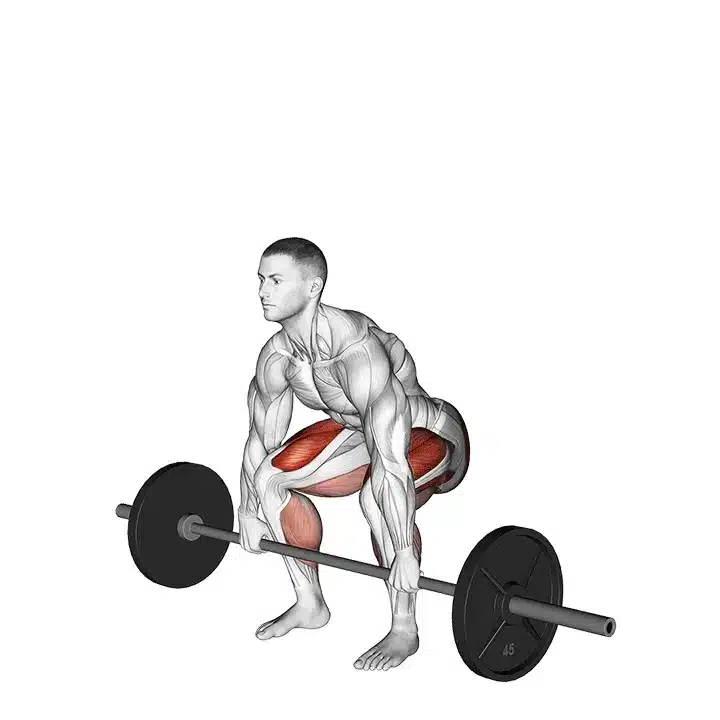
Deadlifts are a compound exercise that targets the lower glutes, hamstrings, and lower back.
How to do Deadlifts:
- Stand with your feet hip-width apart and a barbell in front of you.
- Bend at the hips and knees to lower your body and grab the barbell with an overhand grip.
- Push through your heels to stand up straight, keeping the barbell close to your body.
- Lower back down and repeat.
Romanian Deadlifts
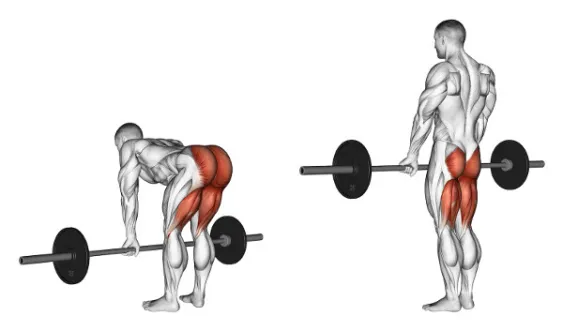
Romanian deadlifts are a variation of the classic deadlift that targets the lower glutes, hamstrings, and lower back.
How to do Romanian Deadlifts:
- Stand with your feet hip-width apart and a barbell in front of you.
- Hold the barbell with an overhand grip and keep your knees slightly bent.
- Hinge at the hips to lower the barbell towards the ground, keeping your back straight.
- Return to the starting position and repeat.
Single Leg Romanian Deadlift
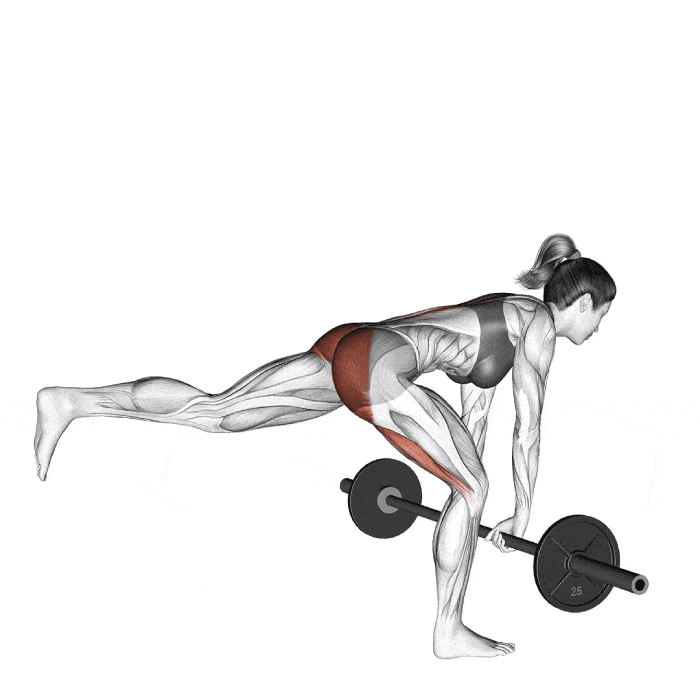
Single-leg deadlifts are a great way to isolate the lower glutes and hamstrings while also improving balance and stability.
How to do Single-Leg Deadlifts:
- Stand on one leg, holding a dumbbell in the opposite hand.
- Hinge at the hips, lowering the weight while keeping your back straight.
- Return to the starting position, squeezing your glutes at the top.
- Repeat on the other side.
Stiff-Leg Deadlifts

Stiff-leg deadlifts are a fantastic exercise to target the lower glutes and hamstrings. This exercise requires a barbell or dumbbells and focuses on hip hinge movement.
How to do Stiff-Leg Deadlifts:
- Stand with feet shoulder-width apart, holding a barbell or dumbbells in front of you.
- Keep your legs straight with a slight bend in the knees.
- Hinge at the hips, lowering the weight while keeping your back straight.
- Squeeze your glutes and return to the starting position.
Good Mornings

Good mornings are another excellent exercise for targeting the lower glutes and hamstrings. This exercise requires a barbell placed on your shoulders.
How to do Good Mornings:
- Stand with feet shoulder-width apart, barbell resting on your shoulders.
- Keep your legs straight with a slight bend in the knees.
- Hinge at the hips, lowering your torso while keeping your back straight.
- Return to the starting position, squeezing your glutes at the top.
Lunges

Lunges are a classic exercise that targets the lower glutes, quads, and hamstrings.
How to do Lunges:
- Stand with feet hip-width apart.
- Step forward into a lunge, keeping your front knee behind your toes.
- Push through your front heel to return to the starting position.
- Repeat on the other side.
Bulgarian Split Squats

Bulgarian split squats are a fantastic exercise to target the lower glutes, quads, and hamstrings. This exercise requires a bench or elevated surface.
How to do Bulgarian Split Squats:
- Stand facing away from a bench, placing one foot on it.
- Lower your body into a lunge, keeping your front knee behind your toes.
- Push through your front heel to return to the starting position.
- Repeat on the other side.
Step-Ups

Step-ups are a great exercise to target the lower glutes, quads, and hamstrings. This exercise requires a bench or step.
Some studies say they’re one of the best exercises for glutes activation.
How to do Step-Ups:
- Stand in front of a bench or step.
- Step up with one foot, driving through your heel to lift your body.
- Lower back down and repeat on the other side.
Donkey Kicks
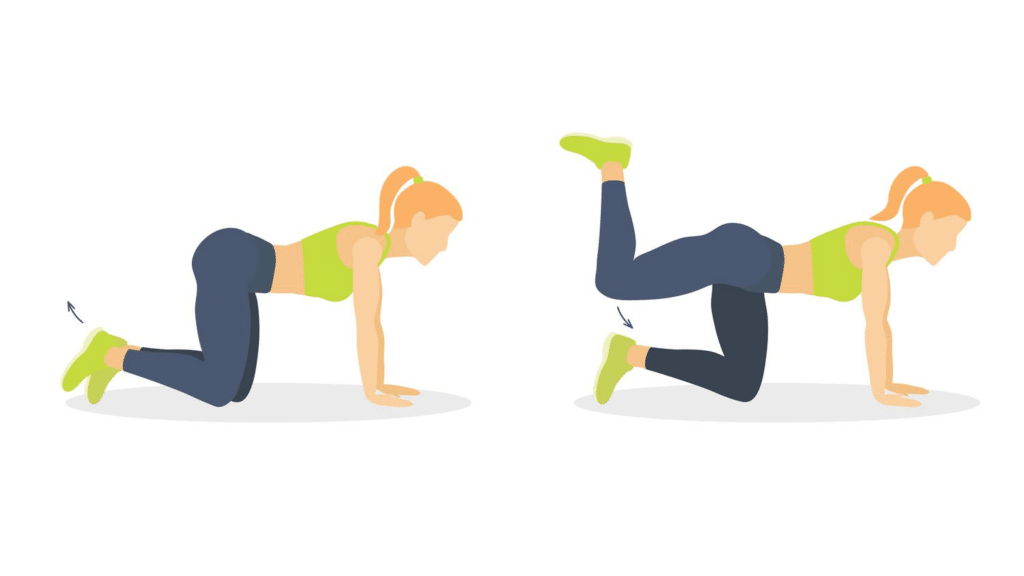
Donkey kicks are a great exercise to build muscle, isolate and target the lower glutes.
How to do Donkey Kicks:
- Start on all fours, with your knees under your hips and your hands under your shoulders.
- Lift one leg towards the ceiling, keeping your knee bent at 90 degrees.
- Lower back down and repeat on the other side.
Fire Hydrants

Fire hydrants are another excellent exercise to isolate and target the lower glutes.
How to do Fire Hydrants:
- Start on all fours, with your knees under your hips and your hands under your shoulders.
- Lift one leg to the side, keeping your knee bent at 90 degrees.
- Lower back down and repeat on the other side.
Clamshells

Clamshells are a fantastic exercise to target the lower glutes and outer thighs.
How to do Clamshells:
- Lie on your side with your knees bent at 90 degrees.
- Keep your feet together and lift your top knee towards the ceiling.
- Lower back down and repeat on the other side.
Side-Lying Leg Lifts

Side-lying leg lifts are a great exercise to target the lower glutes and outer thighs.
How to do Side-Lying Leg Lifts:
- Lie on your side with your legs straight.
- Lift your top leg towards the ceiling, keeping it straight.
- Lower back down and repeat on the other side.
Quadruped Hip Extensions

Quadruped hip extensions are a fantastic exercise to target the lower glutes and hamstrings.
How to do Quadruped Hip Extensions:
- Start on all fours, with your knees under your hips and your hands under your shoulders.
- Lift one leg towards the ceiling, keeping it straight.
- Lower back down and repeat on the other side.
Stability Ball Glute Bridge with Hamstring Curl
This exercise combines a glute bridge with a hamstring curl, targeting the lower glutes and hamstrings.
How to do Stability Ball Glute Bridge with Hamstring Curl:
- Lie on your back with your feet on a stability ball.
- Lift your hips towards the ceiling, squeezing your glutes.
- Curl the ball towards you, bending your knees.
- Return to the starting position and repeat.
Prone Bench Lying Dumbbell Hamstring Curl
This exercise targets the lower glutes and hamstrings, requiring a bench and a dumbbell.
How to do Prone Bench Lying Dumbbell Hamstring Curl:
- Lie face down on a bench with a dumbbell between your feet.
- Curl the dumbbell towards your glutes, squeezing at the top.
- Slowly lower back down and repeat.
Workout Routines for the Underbutt
Building a strong and well-defined lower glute requires a strategic approach to your workout routine. Here are some sample workout routines and tips to help you target those lower glutes effectively.
Sample Workout Routines Incorporating the Best Exercises
Routine 1: Beginner’s Workout
- Glute Bridges – 3 sets of 12 reps
- Clamshells – 3 sets of 15 reps per side
- Donkey Kicks – 3 sets of 12 reps per side
- Side-Lying Leg Lifts – 3 sets of 15 reps per side
Routine 2: Intermediate Workout
- Single-Leg Glute Bridges – 3 sets of 10 reps per side
- Bulgarian Split Squats – 3 sets of 10 reps per side
- Step-Ups – 3 sets of 12 reps per side
- Cable Kickbacks – 3 sets of 12 reps per side
Routine 3: Advanced Workout
- Barbell Hip Thrusts – 4 sets of 8 reps
- Walking Lunges – 4 sets of 10 reps per side
- Deadlifts – 4 sets of 8 reps
- Weighted Step-Ups – 4 sets of 10 reps per side
Tips for Creating a Balanced Workout Routine
- Always start with a dynamic warm-up to prepare your muscles for the workout.
- Incorporate a mix of compound and isolation exercises to target the lower glutes from different angles.
- Pay attention to your form to ensure you’re activating the right muscles.
- Finish with a cool-down and stretching to aid recovery.
How to Progressively Overload for Growth
Progressive overload is key to muscle growth. Here are some ways to progressively overload your lower glutes:
- Increase the weight you’re lifting over time.
- Add more reps or sets to your exercises.
- Incorporate more challenging variations of the exercises.
- Reduce rest time between sets to increase intensity.
Nutrition and Recovery
When it comes to building strong, well-defined lower glutes, your workout routine is just one piece of the puzzle. Proper nutrition and recovery are equally important to ensure you’re getting the most out of your efforts.
Importance of Proper Nutrition for Muscle Growth
Fueling your body with the right nutrients is crucial for muscle growth and overall performance. Here are some key points to keep in mind:
- Protein: Essential for muscle repair and growth. Aim to include a source of lean protein in every meal.
- Carbohydrates: Provide energy for your workouts. Opt for whole grains and fruits to fuel your body.
- Fats: Essential for overall health. Include sources of healthy fats like avocados, nuts, and olive oil in your diet.
- Hydration: Staying hydrated is key for optimal performance and recovery. Aim to drink at least 8 cups of water per day.
Tips for Optimizing Recovery
Recovery is when your muscles repair and grow stronger. Here are some tips to optimize your recovery:
- Rest: Give your muscles time to recover by taking rest days and getting enough sleep.
- Stretching and Mobility: Incorporate stretching and mobility exercises to improve flexibility and reduce the risk of injury.
- Foam Rolling: Helps to release muscle tightness and improve blood flow.
- Active Recovery: Gentle activities like walking or yoga can help to reduce muscle soreness and improve recovery.
Common Mistakes to Avoid
Avoid these common mistakes to ensure you’re getting the most out of your nutrition and recovery:
- Skipping Meals: Ensure you’re fueling your body with the right nutrients before and after your workout.
- Not Getting Enough Sleep: Aim for 7-9 hours of sleep per night to allow your muscles to recover.
- Ignoring Pain: Listen to your body and consult a healthcare professional if you experience any pain or discomfort.
- Overtraining: Give your muscles time to recover by taking rest days and not overdoing it in the gym.
FAQs
How do you work your lower glutes?
To effectively work your lower glutes, focus on exercises that target the gluteus maximus and gluteus medius. These include hip thrusts, glute bridges, and lunges. Incorporate a mix of compound and isolation exercises into your routine, and ensure you’re using proper form to engage the lower glutes.
What are lower glutes exercises I can do at home?
You can perform a variety of lower glute exercises at home with minimal equipment. Some examples include:
Glute bridges
Donkey kicks
Fire hydrants
Side leg raises
Lunges
Use body weight or add resistance with bands or weights to increase intensity.
How do you isolate your lower glutes?
Isolating the lower glutes requires focusing on exercises that specifically target the gluteus maximus and gluteus medius. Some effective isolation exercises include:
Single-leg glute bridges
Clamshells
Quadruped leg lifts
Step-ups
Ensure you’re using proper form and controlling the movement to fully engage the lower glutes.
How do I activate my glutes and lower back?
To activate your glutes and lower back, start with a proper warm-up that includes dynamic stretching and mobility exercises. Incorporate exercises that target the glutes, lower back, and core, such as:
Deadlifts
Hip thrusts
Plank variations
Bird dogs
Focus on engaging the glutes and lower back muscles throughout each movement.
What are some underbutt isolation exercises?
Underbutt isolation exercises specifically target the lower part of the glutes and can include:
Hip thrusts with a focus on the lower glute squeeze
Single-leg deadlifts
Bulgarian split squats
Cable kickbacks
These exercises isolate the lower glutes by engaging them throughout the movement, helping to sculpt and strengthen the area.
Sources
- https://www.acefitness.org/getfit/GlutesStudy2006.pdf
- https://www.ncbi.nlm.nih.gov/pmc/articles/PMC4713798/
- Moore, Damien et al. “Rehabilitation Exercises for the Gluteus Medius Muscle Segments: An Electromyography Study.” Journal of sport rehabilitation vol. 28,8 (2019): jsr.2018-0340. doi:10.1123/jsr.2018-0340



